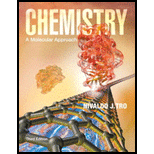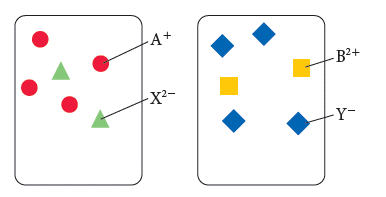
Chemistry: A Molecular Approach
3rd Edition
ISBN: 9780321809247
Author: Nivaldo J. Tro
Publisher: Prentice Hall
expand_more
expand_more
format_list_bulleted
Concept explainers
Textbook Question
Chapter 4, Problem 138E
Consider the generic ionic compounds with the formulas A2X and BY2 and the following solubility rules:
A2X soluble; BY2 soluble; AY insoluble; BX soluble.
Assume A+ ions are circles, B2+ ions are squares, X2– ions are triangles, and Y– ions are diamonds. Solutions of the two compounds (A2X and BY2) are represented as follows:

Draw a molecular-level representation showing the result of mixing the two given solutions and write an equation to represent the reaction.
Expert Solution & Answer
Want to see the full answer?
Check out a sample textbook solution
Students have asked these similar questions
Using the following two half-reactions, determine the pH range in which $NO_2^-\ (aq)$ cannot be found as the predominant chemical species in water.* $NO_3^-(aq)+10H^+(aq)+8e^-\rightarrow NH_4^+(aq)+3H_2O(l),\ pE^{\circ}=14.88$* $NO_2^-(aq)+8H^+(aq)+6e^-\rightarrow NH_4^+(aq)+2H_2O(l),\ pE^{\circ}=15.08$
Indicate characteristics of oxodec acid.
What is the final product when hexanedioic acid reacts with 1º PCl5 and 2º NH3.
Chapter 4 Solutions
Chemistry: A Molecular Approach
Ch. 4 - Prob. 1SAQCh. 4 - Q2. Sodium and chlorine react to form sodium...Ch. 4 - Prob. 3SAQCh. 4 - Prob. 4SAQCh. 4 - Prob. 5SAQCh. 4 - Prob. 6SAQCh. 4 - Prob. 7SAQCh. 4 - Prob. 8SAQCh. 4 - Prob. 9SAQCh. 4 - Q10. What is the net ionic equation for the...
Ch. 4 - Q11. What is the net ionic equation for the...Ch. 4 - Q12. What is the net ionic equation for the...Ch. 4 - Prob. 13SAQCh. 4 - Prob. 14SAQCh. 4 - Prob. 15SAQCh. 4 - 1. What is reaction stoichiometry? What is the...Ch. 4 - Prob. 2ECh. 4 - Prob. 3ECh. 4 - Prob. 4ECh. 4 - 5. What is molarity? How is it useful?
Ch. 4 - 6. Explain how a strong electrolyte, a weak...Ch. 4 - 7. Explain the difference between a strong acid...Ch. 4 - Prob. 8ECh. 4 - Prob. 9ECh. 4 - Prob. 10ECh. 4 - Prob. 11ECh. 4 - Prob. 12ECh. 4 - Prob. 13ECh. 4 - Prob. 14ECh. 4 - 15. What is an acid–base reaction? Give an...Ch. 4 - 16. Explain the principles behind an acid–base...Ch. 4 - 17. What is a gas-evolution reaction? Give an...Ch. 4 - 18. What reactant types give rise to gas-evolution...Ch. 4 - Prob. 19ECh. 4 - Prob. 20ECh. 4 - Prob. 21ECh. 4 - Prob. 22ECh. 4 - 23. In a redox reaction, which reactant is the...Ch. 4 - Prob. 24ECh. 4 - Prob. 25ECh. 4 - Prob. 26ECh. 4 - 27. Calculate how many moles of NO2 form when each...Ch. 4 - 28. Calculate how many moles of NH3 form when each...Ch. 4 - Prob. 29ECh. 4 - Prob. 30ECh. 4 - Prob. 31ECh. 4 - Prob. 32ECh. 4 - 33. For each of the reactions, calculate the mass...Ch. 4 - 34. For each of the reactions, calculate the mass...Ch. 4 - 35. For each of the acid–base reactions, calculate...Ch. 4 - Prob. 36ECh. 4 - 37. Find theFor the following reaction, determine ...Ch. 4 - 38. Find the limiting reactant for each initial...Ch. 4 - Prob. 39ECh. 4 - Prob. 40ECh. 4 - Prob. 41ECh. 4 - 42. Calculate the theoretical yield of product (in...Ch. 4 - Zinc sulfide reacts with oxygen according to the...Ch. 4 - 44. Iron(II) sulfide reacts with hydrochloric acid...Ch. 4 - Prob. 45ECh. 4 - Prob. 46ECh. 4 - 47. Iron(III) oxide reacts with carbon monoxide...Ch. 4 - 48. Elemental phosphorus reacts with chlorine gas...Ch. 4 - 49. Lead ions can be precipitated from solution...Ch. 4 - Prob. 50ECh. 4 - Prob. 51ECh. 4 - Prob. 52ECh. 4 - 53. Calculate the molarity of each solution.
a....Ch. 4 - Prob. 54ECh. 4 - 55. What is the molarity of NO3– in each...Ch. 4 - Prob. 56ECh. 4 - Prob. 57ECh. 4 - 58. What volume of 0.200 M ethanol solution...Ch. 4 - Prob. 59ECh. 4 - Prob. 60ECh. 4 - 61. If 123 mL of a 1.1 M glucose solution is...Ch. 4 - 62. If 3.5 L of a 4.8 M SrCl2 solution is diluted...Ch. 4 - 63. To what volume should you dilute 50.0 mL of a...Ch. 4 - 64. To what volume should you dilute 25 mL of a...Ch. 4 - Prob. 65ECh. 4 - 66. Consider the reaction:
Li2S(aq) + Co(NO3)2(aq)...Ch. 4 - 67. What is the minimum amount of 6.0 M H2SO4...Ch. 4 - Prob. 68ECh. 4 - 69. A 25.0-mL sample of a 1.20 M potassium...Ch. 4 - Prob. 70ECh. 4 - Prob. 71ECh. 4 - Prob. 72ECh. 4 - Prob. 73ECh. 4 - Prob. 74ECh. 4 - Prob. 75ECh. 4 - 76. Complete and balance each equation. If no...Ch. 4 - Write a molecular equation for the precipitation...Ch. 4 - 78. Write a molecular equation for the...Ch. 4 - Prob. 79ECh. 4 - 80. Write balanced complete ionic and net ionic...Ch. 4 - Prob. 81ECh. 4 - Prob. 82ECh. 4 - 83. Write balanced molecular and net ionic...Ch. 4 - Prob. 84ECh. 4 - Prob. 85ECh. 4 - Prob. 86ECh. 4 - Prob. 87ECh. 4 - 90. A 30.00-mL sample of an unknown H3PO4 solution...Ch. 4 - Prob. 89ECh. 4 - Prob. 90ECh. 4 - Prob. 91ECh. 4 - Prob. 92ECh. 4 - Prob. 93ECh. 4 - Prob. 94ECh. 4 - Prob. 95ECh. 4 - Prob. 96ECh. 4 - Prob. 97ECh. 4 - Prob. 98ECh. 4 - Prob. 99ECh. 4 - Prob. 100ECh. 4 - 103. People sometimes use sodium bicarbonate as an...Ch. 4 - 104. Toilet bowl cleaners often contain...Ch. 4 - Prob. 103ECh. 4 - Many home barbeques are fueled with propane gas...Ch. 4 - Prob. 105ECh. 4 - Prob. 106ECh. 4 - Prob. 107ECh. 4 - 110. A hydrochloric acid solution will neutralize...Ch. 4 - 111. Predict the products and write a balanced...Ch. 4 - 112. Predict the products and write a balanced...Ch. 4 - Prob. 111ECh. 4 - Prob. 112ECh. 4 - Prob. 113ECh. 4 - Prob. 114ECh. 4 - 117. The nitrogen in sodium nitrate and in...Ch. 4 - 118. Find the volume of 0.110 M hydrochloric acid...Ch. 4 - Prob. 117ECh. 4 - 120. We prepare a solution by mixing 0.10 L of...Ch. 4 - Prob. 119ECh. 4 - Prob. 120ECh. 4 - Prob. 121ECh. 4 - 124. An important reaction that takes place in a...Ch. 4 - 125. A liquid fuel mixture contains 30.35% hexane...Ch. 4 - 126. Titanium occurs in the magnetic mineral...Ch. 4 - Prob. 125ECh. 4 - Prob. 126ECh. 4 - Prob. 127ECh. 4 - Prob. 128ECh. 4 - 131. Recall from Section 4.6 that sodium carbonate...Ch. 4 - 132. Lead poisoning is a serious condition...Ch. 4 - Prob. 131ECh. 4 - Prob. 132ECh. 4 - Prob. 133ECh. 4 - Prob. 134ECh. 4 - Prob. 135ECh. 4 - Prob. 136ECh. 4 - Prob. 137ECh. 4 - Consider the generic ionic compounds with the...
Knowledge Booster
Learn more about
Need a deep-dive on the concept behind this application? Look no further. Learn more about this topic, chemistry and related others by exploring similar questions and additional content below.Similar questions
- What is the final product when D-galactose reacts with hydroxylamine?arrow_forwardIndicate the formula of the product obtained by reacting methyl 5-chloro-5-oxopentanoate with 1 mole of 4-penten-1-ylmagnesium bromide.arrow_forwardIn the two chair conformations of glucose, the most stable is the one with all the OH groups in the equatorial position. Is this correct?arrow_forward
- please help me with my homeworkarrow_forwardhelparrow_forwardThe temperature on a sample of pure X held at 1.25 atm and -54. °C is increased until the sample boils. The temperature is then held constant and the pressure is decreased by 0.42 atm. On the phase diagram below draw a path that shows this set of changes. pressure (atm) 2 0 0 200 400 temperature (K) Xarrow_forward
- QUESTION: Answer Question 5: 'Calculating standard error of regression' STEP 1 by filling in all the empty green boxes *The values are all provided in the photo attached*arrow_forwardpressure (atm) 3 The pressure on a sample of pure X held at 47. °C and 0.88 atm is increased until the sample condenses. The pressure is then held constant and the temperature is decreased by 82. °C. On the phase diagram below draw a path that shows this set of changes. 0 0 200 temperature (K) 400 аarrow_forwarder your payment details | bar xb Home | bartleby x + aleksogi/x/isl.exe/1o u-lgNskr7j8P3jH-1Qs_pBanHhviTCeeBZbufuBYT0Hz7m7D3ZcW81NC1d8Kzb4srFik1OUFhKMUXzhGpw7k1 O States of Matter Sketching a described thermodynamic change on a phase diagram 0/5 The pressure on a sample of pure X held at 47. °C and 0.88 atm is increased until the sample condenses. The pressure is then held constant and the temperature is decreased by 82. °C. On the phase diagram below draw a path that shows this set of changes. pressure (atm) 1 3- 0- 0 200 Explanation Check temperature (K) 400 X Q Search L G 2025 McGraw Hill LLC. All Rights Reserved Terms of Use Privacy Cearrow_forward
arrow_back_ios
SEE MORE QUESTIONS
arrow_forward_ios
Recommended textbooks for you
 ChemistryChemistryISBN:9781305957404Author:Steven S. Zumdahl, Susan A. Zumdahl, Donald J. DeCostePublisher:Cengage Learning
ChemistryChemistryISBN:9781305957404Author:Steven S. Zumdahl, Susan A. Zumdahl, Donald J. DeCostePublisher:Cengage Learning Chemistry: An Atoms First ApproachChemistryISBN:9781305079243Author:Steven S. Zumdahl, Susan A. ZumdahlPublisher:Cengage Learning
Chemistry: An Atoms First ApproachChemistryISBN:9781305079243Author:Steven S. Zumdahl, Susan A. ZumdahlPublisher:Cengage Learning
 Chemistry: The Molecular ScienceChemistryISBN:9781285199047Author:John W. Moore, Conrad L. StanitskiPublisher:Cengage Learning
Chemistry: The Molecular ScienceChemistryISBN:9781285199047Author:John W. Moore, Conrad L. StanitskiPublisher:Cengage Learning Introductory Chemistry: A FoundationChemistryISBN:9781337399425Author:Steven S. Zumdahl, Donald J. DeCostePublisher:Cengage Learning
Introductory Chemistry: A FoundationChemistryISBN:9781337399425Author:Steven S. Zumdahl, Donald J. DeCostePublisher:Cengage Learning General Chemistry - Standalone book (MindTap Cour...ChemistryISBN:9781305580343Author:Steven D. Gammon, Ebbing, Darrell Ebbing, Steven D., Darrell; Gammon, Darrell Ebbing; Steven D. Gammon, Darrell D.; Gammon, Ebbing; Steven D. Gammon; DarrellPublisher:Cengage Learning
General Chemistry - Standalone book (MindTap Cour...ChemistryISBN:9781305580343Author:Steven D. Gammon, Ebbing, Darrell Ebbing, Steven D., Darrell; Gammon, Darrell Ebbing; Steven D. Gammon, Darrell D.; Gammon, Ebbing; Steven D. Gammon; DarrellPublisher:Cengage Learning

Chemistry
Chemistry
ISBN:9781305957404
Author:Steven S. Zumdahl, Susan A. Zumdahl, Donald J. DeCoste
Publisher:Cengage Learning

Chemistry: An Atoms First Approach
Chemistry
ISBN:9781305079243
Author:Steven S. Zumdahl, Susan A. Zumdahl
Publisher:Cengage Learning


Chemistry: The Molecular Science
Chemistry
ISBN:9781285199047
Author:John W. Moore, Conrad L. Stanitski
Publisher:Cengage Learning

Introductory Chemistry: A Foundation
Chemistry
ISBN:9781337399425
Author:Steven S. Zumdahl, Donald J. DeCoste
Publisher:Cengage Learning

General Chemistry - Standalone book (MindTap Cour...
Chemistry
ISBN:9781305580343
Author:Steven D. Gammon, Ebbing, Darrell Ebbing, Steven D., Darrell; Gammon, Darrell Ebbing; Steven D. Gammon, Darrell D.; Gammon, Ebbing; Steven D. Gammon; Darrell
Publisher:Cengage Learning
Acid-Base Titration | Acids, Bases & Alkalis | Chemistry | FuseSchool; Author: FuseSchool - Global Education;https://www.youtube.com/watch?v=yFqx6_Y6c2M;License: Standard YouTube License, CC-BY